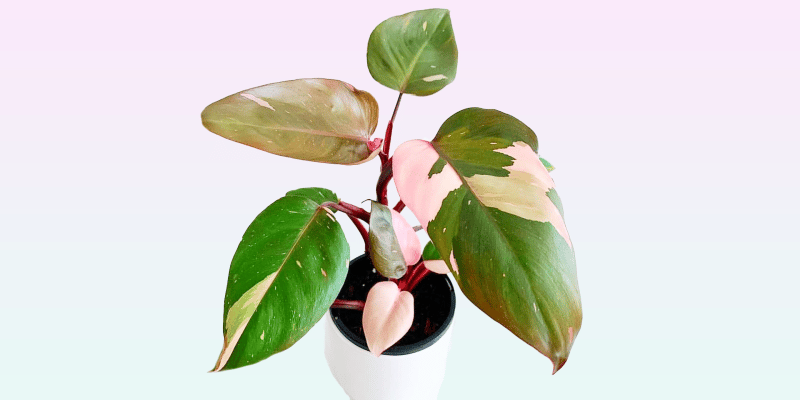Philodendron erubescens (Blushing Philodendron) is well-known for two main reasons: you can train its stems to grow in any shape you want, and it has such stunning varieties!
Depending on which variety you have, you’ll see deep green leathery leaves with vibrant red, black, pink, or even orange coloring. But how to tell the difference between an ‘Imperial Red’ Philodendron or a ‘Red Emerald’ Philodendron plant? How does their care differ?
We’ve got you covered.
Fortunately, taking care of Philodendron erubescens is pretty easy. As a bonus, they even purify the air. And did you know that you, and only you, can get them to bloom?
(You have to be sneaky).
Table of Contents
Philodendron Erubescens Care Guide
History, habitat, and characteristics
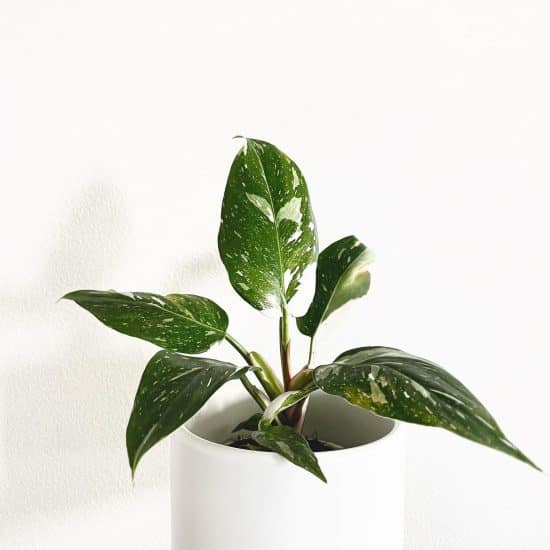
Blushing Philodendron, or Philodendron erubescens, is native to the tropical rainforests of Colombia, where it can often reach heights of up to 60 feet. But don’t worry — this member of the Araceae family typically maxes out at 3 feet when kept indoors. Phew!
Philodendron is Latin for “lover of trees” and erubescens means “blushing,” so there you have it, our blushing tree lover! It’s one of 400 philodendron species around the world.
Also called Red-leaf Philodendron, it’s got glossy, heart-shaped foliage that first emerges as a mix of dark red and deep green, but eventually turns entirely deep green as the plant grows (although some varieties have leaves that retain a maroon or coppery hue underneath when they mature). Leaves grow anywhere from 10 to 16 inches long.
As they mature, their leaves seem to grow almost downward with stems taking on a beautiful burgundy shade. To show off this eye-catching foliage, consider placing your plant in a hanging basket and watch as it cascades down in all its glory!
Blushing Philodendron is an epiphytic plant, which means it naturally grows on another surface in its native environment. You’ll notice it forming aerial roots that seek out other plants, structures, and honestly whatever they can find. If you’re looking to incorporate a moss pole, its roots will grab on tight!
This is where your creativity can shine — use U-shaped pins (you can get these at a craft or plant store) to train its stems in any direction you like!
Flowers
You can get your Philodendron erubescens to bloom, but you have to be sneaky about it. Wait until night when it opens its spathe, then put pollen into the spadix. The best time to do this is in spring and summer. (Yup, you have to do it yourself, since this plant isn’t self-pollinating. It’s an act of love!). If everything goes well, you’ll see deep red flowers.
Enough about pollinating — let’s get to the good stuff, the variants!
Philodendron erubescens Varieties
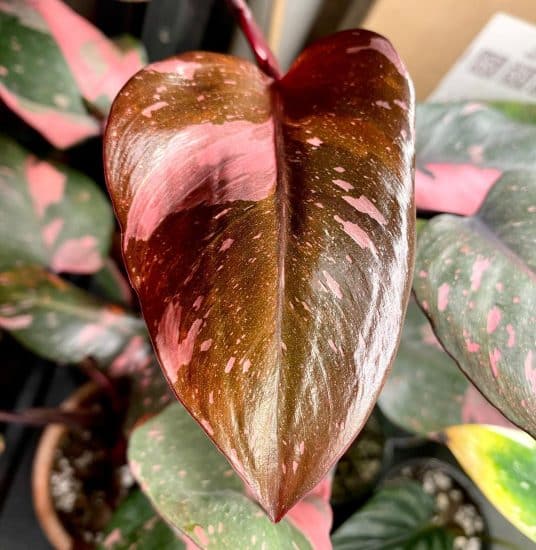
You might be more familiar with the ‘Birkin’ and ‘Rojo Congo’ variants, but there are over a dozen in total. Here are some of the most popular.
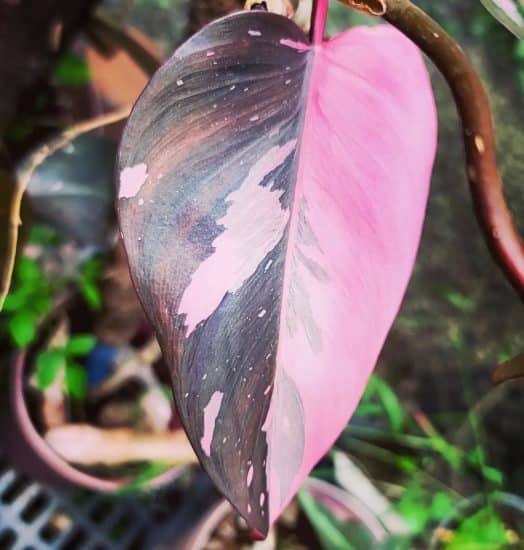
P. erubescens ‘Pink Princess’ – Marbled with pink and green coloration. Foliage changes color depending on the intensity of light it receives.
P. erubescens ‘Imperial Red’ – Has a warmer shade of pink around the edges of the leaves. Grows like a shrub and is self-heading (leaves grow so closely together that you can’t see its stem until some of the older, lower leaves fall off). More sensitive to direct sunlight and more prone to scorching than other varieties. Read more about the Imperial Red here.
P. erubescens ‘Red Emerald’ – Leaves first emerge red, then turn to green as the plant matures. Has burgundy-colored stems, with red midribs, petiole, and veins. Unlike the ‘Imperial Red,’ this is a climbing plant.
P. erubescens ‘Green Emerald’ – There’s a lot of debate about whether this is actually a separate variety or just a version of the ‘Red Emerald’ that received more sunlight. The jury’s out on this one for now!
P. erubescens ‘Imperial Green’ – Has large, glossy, entirely green leaves that fan out from a central stem.
(Our full Philodendron ‘Imperial Green’ care guide).
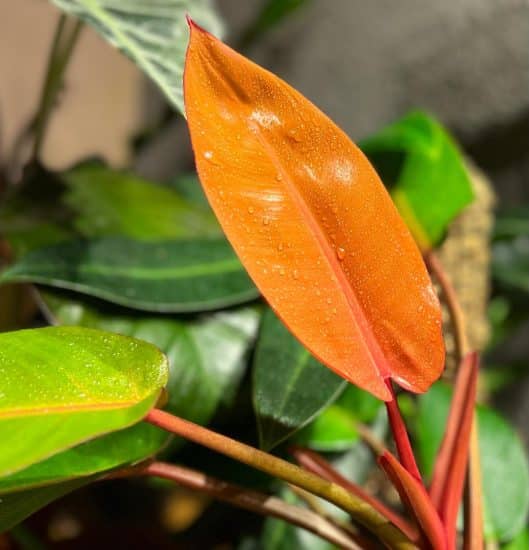
P. erubescens ‘Prince of Orange’ – New leaves are yellow, then turn bright orange, finally maturing into dark green hues. Like the ‘Pink Princess,’ this hybrid needs a lot of light to keep its bright colors. Read more about the Prince of Orange here.
P. erubescens ‘Burgundy’ – Has green leaves boasting a red blush, with wine-colored stems and leaf undersides.
P. erubescens ‘White Princess’ – A relatively rare variety with red and white stems, and green and white leaves. Not to be confused with Philodendron ‘White Knight’ or Philodendron ‘White Wizard’!
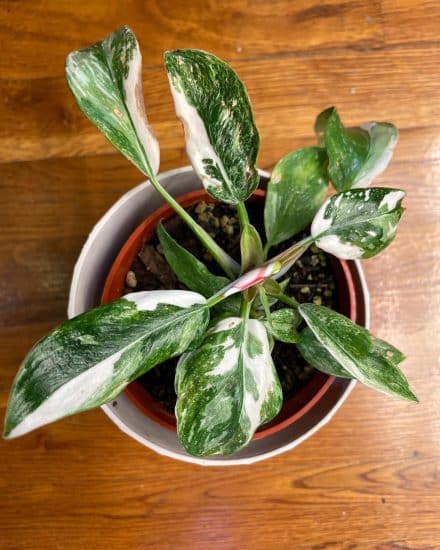
The good thing is, all varieties of Philodendron erubescens thrive in similar conditions, with temperatures above 55 degrees Fahrenheit. Speaking of, let’s talk about the ideal environment for this plant. We’ll start with lighting conditions, where variegated plants tend to be a bit more particular.
Light
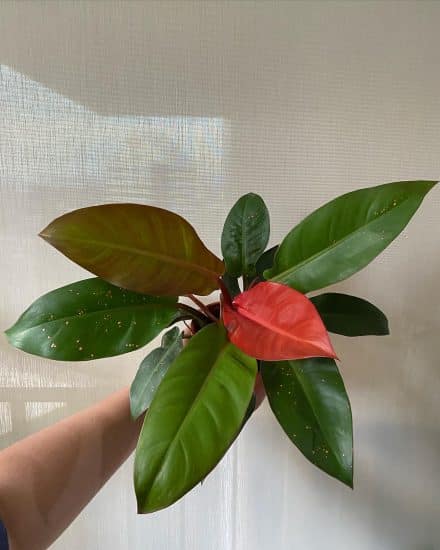
Philodendron erubescens loves bright indirect light. Here’s the catch: it can be easily scorched or damaged by too much direct sunlight, but also requires enough light to keep its foliage healthy and vibrant. What to do?
A north or east-facing window is a good choice for this plant, since both let in a ton of indirect sunlight. If you have your plant near a south or west-facing window, however, put it at least 3-5 feet away, or consider hanging up a sheer curtain to lessen the effect of rays that are too bright.
You’ll know if your Blushing Philodendron isn’t getting enough light if the leaves are pale, have reduced variegation, and aren’t growing well, or if your plant isn’t producing new leaves. On the other hand, it might be getting too much light if leaves are wilting, brown, or discolored.
If you have a Red Leaf philodendron, Red emerald philodendron, or another of the variegated philodendron erubescens varieties, you’ll want to make sure they get plenty of indirect light. Less chlorophyll in the leaves means they really do want more light.
Water
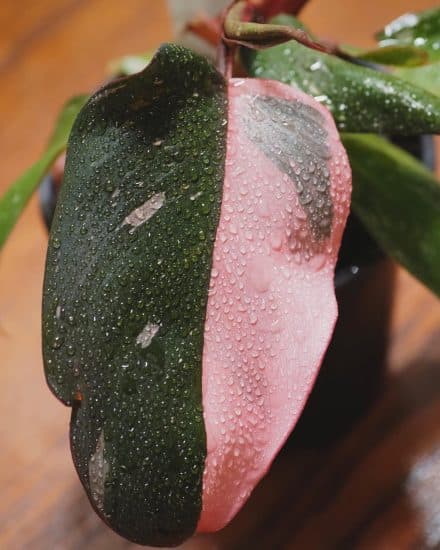
When it comes to keeping your beloved Philodendron erubescens happy, water is your best friend. Just like with light, you want to hit that sweet spot between too much water and not enough.
Rather than sticking to a rigid watering schedule, let your plant tell you what it needs when. You can test the soil by sticking one finger an inch or two beneath the surface; if it feels damp, you don’t need to water yet!
Thankfully, Philodendron erubescens has a knack for letting you know when it’s ready for a drink — when it’s thirsty, leaves might look dull or limp with brown or yellow edges, and the soil may become dry and detach itself from the edge of the pot.
In general, you’ll be watering more frequently during the spring and summer months when there’s plenty of moist air and sunlight), than the winter ones (when, to no one’s surprise, there isn’t).
(If you have access to filtered or bottled water, or even rainwater, consider using it instead of tap water, since the salt and other chemicals tap contains can sometimes burn your plant.)
Temperature and humidity
Philodendron erubescens come from the rainforests of South America and thrive in USDA Hardiness Zones 10-11, so you’d better believe they like warm, humid environments. In fact, they prefer temperatures between 60 to 80 degrees Fahrenheit — the higher, the better.
Anything lower than 55 degrees can cause some serious damage to the plant, as it’s not cold-tolerant.
Humidity plays an equally important role in Philodendron erubescens care. Again, think tropical plants. They thrive in higher levels of humidity, so aim for at least 50-60%. Most people don’t keep their houses that humid (I know I don’t), but there are ways you can create a more humid area just for your plant.
Try grouping plants together so they can share humidity as leaves collectively trap more moisture, or set up a pebble tray. Fill a tray up with water and rocks, and place your pot on top. The water will evaporate and slowly raise the humidity around your plant—and not your whole house.
No wiping sweaty brows here!
Soil and planting
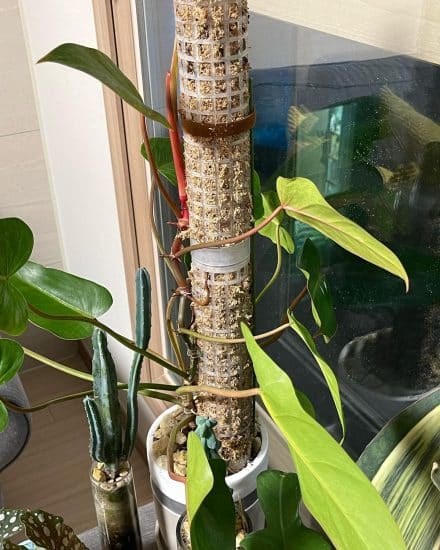
To live its best plant life, Philodendron erubescens needs a well-aerated, slightly acidic soil mix with a pH between 5.8 and 7.5. You can buy an aroid potting mix for your plant or create your own. An ideal combination includes:
- 40% orchid bark
- 30% potting soil
- 20% sphagnum moss or peat moss
- 10% perlite
Keep in mind that the potting mix you choose isn’t set in stone — feel free to experiment with what works best for your plant.
As long as the combo is bark-based, has some chunky bits thrown in that help with drainage (coco coir, anyone?), and retains enough moisture to keep the soil moist but not waterlogged, your Philo will love you for it.
Tips: Consider using LECA to aerate the soil more. Need more minerals and nutrients? Throw in a handful of horticultural charcoal.
Pruning
As with other Philodendron plants, prune off dead or diseased leaves with sterilized scissors or pruning shears. If your plant is looking leggy or unruly, you can also prune it to encourage bushier, shapelier growth.
Repotting
Since Blushing Philodendron are fairly quick-growing plants, repot them every year in the spring or summer when they’re actively growing. Use a pot one size larger than the previous with at least one drainage hole.
Fertilizing
Once or twice a month, fertilize your Philodendron erubescens with a diluted balanced liquid houseplant fertilizer (15-15-15 or 10-10-10). Take care not to fertilize in winter, since your plant will be dormant then and unable to use the nutrients.
Now that we know all about this Philodendron’s ideal environment, let’s get into the good stuff — how to make more of them!
Propagation guide
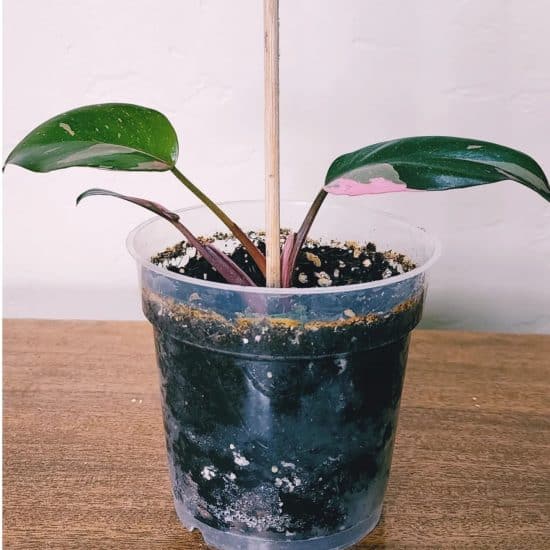
Propagating Philodendron erubescens is an easy way to increase your indoor plant collection and share this beautiful houseplant with loved ones. There are two main ways to do it, by stem cuttings and division.
Stem cuttings in water or soil are the absolute easiest route, but it does require a bit of patience. If you choose the water route, roots will grow quickly but will be weaker and might have more trouble acclimating to soil later on.
If you’re looking for a bigger plant right away and don’t mind getting your hands a little dirty, then division is the better option.
To propagate Philodendron erubescens by stem cutting:
- Use a sterilized knife or shears to cut off a 3-5 inch section of the stem with at least two or three leaves, and ideally multiple aerial roots. (More mature plant leaf nodes have aerial roots that can grab onto surfaces.)
- Remove any leaves from the bottom of the stem that will be placed in water or soil.
- Put the cutting in a small, clean container of soil or water. Make sure it’s in a sunny spot with moderate humidity, out of direct sunlight.
- If using the water method, keep the water level high enough to cover any leaf nodes. Make sure to change the water out every few days to keep it fresh.
- For both methods, when roots have grown several inches long, it’s time to transplant your Philodendron into a slightly bigger container full of soil and let it acclimate to its new environment.
Propagating Philodenron erubescens by division involves dividing the root ball into two or more pieces, then re-potting each one into separate containers with soil like the mother plant. Keep them moist them as needed, avoid overwatering, and voilà, you’ll have new Blushing Philodendrons in no time!
Moving on to common issues those new plants might experience…
Common issues
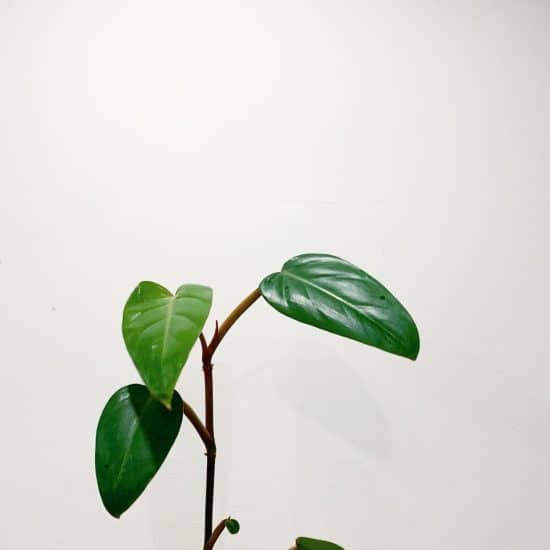
Most issues we see with plants (including Blushing Philodendron) involve the wrong amount of water or sunlight. Really, it’s that simple!
Leaf Discoloration
Leaf discoloration in Philodendron erubescens is usually a sign of overwatering or insufficient light (I’m not going to say I told you so!).
Yellow leaves could be a sign of overwatering or too much sunlight. If your soil is drenched, wait until it dries out before watering again, and don’t water until the soil is dry two inches down. If the soil isn’t waterlogged, move your plant to a shady spot.
Brown leaves could mean that your plant needs more water. If leaves have dark, crispy edges or spots, your plant could be getting too much bright light. If the soil is dry, water away! If it’s wet, you have a light issue and should move your Philodendron farther away from the window.
Dust Accumulation
Dust on your Philodendron’s leaves interrupts their ability to photosynthesize. Gently wipe your plant’s leaves down with a damp cloth every so often to keep it looking great and make pests think twice about stopping by.
Leggy Growth
Leggy stems can be a sign that your Philodendron isn’t getting enough light. To remedy this, simply give it more sunshine, either by moving it closer to a window or giving it supplemental artificial light.
Diseases and pests
Good Philodendron erubescens care can sometimes mean doing battle with unsightly diseases and unwelcome common pests. But don’t worry — diseases Philodendron erubescens are susceptible to aren’t different from those of other plants.
Root Rot: Caused by overwatering or leaving the plant sitting in water for too long. Symptoms include yellowing leaves and brown, decaying roots. To prevent root rot, water only when soil is dry one or two inches down.
To fix this problem, carefully remove your plant from its pot and cut off any affected roots. Re-pot it in dry, fresh soil and avoid watering too much in the future.
Leaf Spot Disease: This is a common issue for philodendron erubescens, caused by a variety of fungi that target the leaves. You’ll see circular black or brown lesions of different sizes, along with yellowing leaves.
To prevent it from occurring in the first place, let the soil dry out before you water and make sure your plant is in an aerated potting mix. If your Philodendron already has leaf spot, isolate the plant if possible so the fungus doesn’t spread, and clean its leaves with fungicide. Don’t water the leaves, since this can spread the fungus more.
Pest Infestations: Pests such as mealybugs, spider mites, and fungus gnats can be a common issue with philodendron erubescens, feeding off the plant’s nutrients and causing damage to leaves and stems.
If you spot those bugs, hit them with insecticidal soap or neem oil to get rid of them.
Conclusion
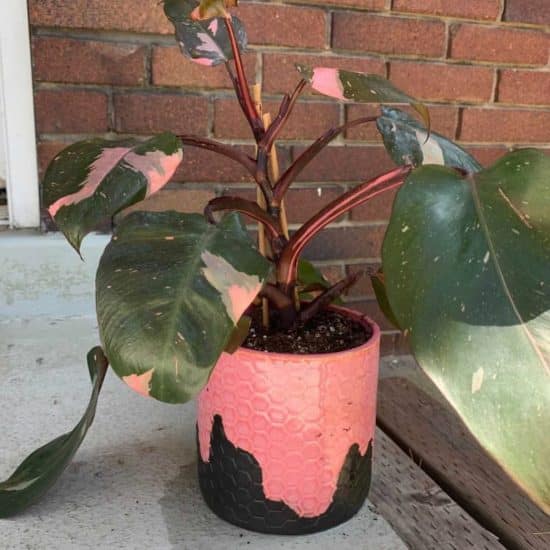
Whether you think a ‘Green Emerald’ Philodendron is really just a ‘Red Emerald’ in disguise (this may be akin to bringing up politics and religion at the dinner table in some households), at least now you know how to take care of them both.
Speaking of, care is super easy for this plant. Give your Philodendron erubescens bright sunlight (indirect!) and moderate to high humidity, water it when the soil is dry two inches down, and plop it into a pot with an aroid soil mix and adequate drainage holes. Done!
Have you lucked into scoring a Philodendron ‘Pink Princess’ or another gorgeous variant? Let us know in the comments!
Is Philodendron erubescens “Pink princess”?
‘Pink Princess’ is a popular pink and green variant of Philodendron erubescens on a lot of people’s wish lists, including mine!
Is Philodendron erubescens a climber?
Yes, yes, and yes! Philodendron erubescens loves to climb, and its aerial roots really appreciate a moss stick for support as this plant grows (think of the pole like a rainforest tree).
How do you identify a Philodendron erubescens?
This plant’s glossy green and red heart-shaped leaves are a dead giveaway, although it can be slightly more tricky trying to differentiate between some of its variants (see our “Varieties” section above for clues).
What is the rarest Philodendron?
As of this writing, the most rare philodendron is Philodendron Spiritus Sancti. It’s an endangered species that’s native to only one state in Brazil (Espirito Santo), and also really, really expensive.
Is Philodendron erubescens toxic?
Yes. According to the ASPCA, Philodendron erubescens is toxic because of the calcium oxalate crystals in its stems and leaves, so keep it away from curious little ones and critters.

